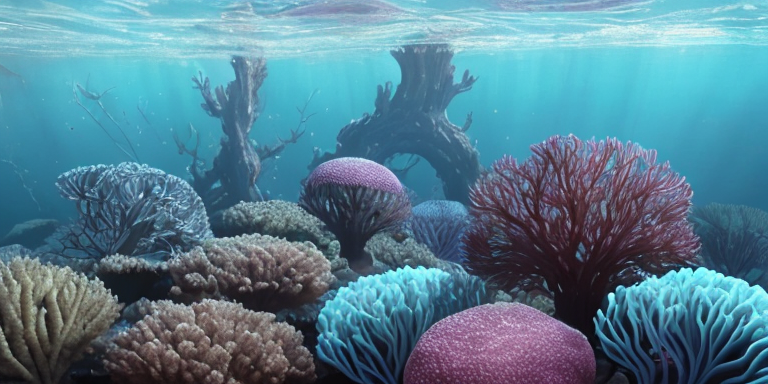A New Species of Jellyfish Discovered in the Depths of the Ocean
The ocean is a vast expanse of mystery and wonder, with depths that have yet to be fully explored. Recently, a team of scientists embarked on a deep-sea expedition, hoping to uncover the secrets of the ocean’s depths. What they discovered was a new species of jellyfish that has never been seen before.
The discovery of a new species is always exciting, but what makes this jellyfish so unique is its bioluminescent properties. This jellyfish glows in the dark, illuminating the surrounding waters with its bright blue light. The implications of this discovery are significant, as it could lead to a better understanding of the ecology and evolution of deep-sea creatures.
The importance of this discovery cannot be overstated. The ocean is home to countless species that have yet to be discovered, and each new discovery provides valuable insights into the workings of our planet. The discovery of this new species of jellyfish is a testament to the importance of continued exploration and research.
As we continue to delve deeper into the ocean’s depths, we are sure to uncover more mysteries and wonders. The discovery of this new species of jellyfish is just the beginning of what promises to be an exciting journey of discovery and exploration.
The Expedition and Discovery
The discovery of the new species of jellyfish was the result of a deep-sea expedition that took place in the Pacific Ocean. The expedition was led by a team of scientists from the Scripps Institution of Oceanography at the University of California San Diego.
The team used a remotely operated vehicle (ROV) to explore the depths of the ocean, reaching depths of up to 3,700 meters. It was during one of these dives that the team came across the new species of jellyfish.
The jellyfish was found in a region of the ocean that is known for its extreme conditions. The water in this region is cold and dark, with very little oxygen. Despite these harsh conditions, the jellyfish was thriving, thanks in part to its bioluminescent properties.
The jellyfish itself is a beautiful creature, with a translucent bell-shaped body and long, glowing tentacles. Its bioluminescent properties are what make it so unique, as the jellyfish is able to produce its own light through a chemical reaction.
Bioluminescence and the Jellyfish
Bioluminescence is the ability of an organism to produce light through a chemical reaction. This process is common in deep-sea creatures, as it allows them to communicate, attract prey, and defend themselves in the dark depths of the ocean.
The new species of jellyfish discovered by the Scripps Institution of Oceanography is no exception. The jellyfish uses bioluminescence to attract prey and defend itself from predators. Its glowing tentacles are a warning to potential predators, signaling that the jellyfish is not to be messed with.
The bioluminescent properties of the jellyfish are also a testament to the incredible adaptability of deep-sea creatures. Despite the harsh conditions of the deep ocean, these creatures have evolved unique and fascinating ways of surviving and thriving.
Significance and Potential Applications
The discovery of this new species of jellyfish has significant implications for the study of deep-sea ecology and evolution. By studying the jellyfish and its bioluminescent properties, scientists can gain a better understanding of how deep-sea creatures have adapted to survive in such extreme conditions.
The glowing tentacles of the jellyfish also have potential applications in the field of bioluminescent technology. The ability to produce light through a chemical reaction has numerous practical applications, from medical imaging to environmental monitoring.
The discovery of this new species of jellyfish is a reminder of the incredible diversity and adaptability of life on our planet. It is also a testament to the importance of continued exploration and research, as we strive to uncover the mysteries of the ocean’s depths.
Conclusion
The discovery of a new species of jellyfish in the depths of the ocean is a testament to the incredible adaptability and diversity of life on our planet. The bioluminescent properties of the jellyfish have significant implications for the study of deep-sea ecology and evolution, as well as potential applications in the field of bioluminescent technology.
As we continue to explore the ocean’s depths, we are sure to uncover more mysteries and wonders. The discovery of this new species of jellyfish is just the beginning of what promises to be an exciting journey of discovery and exploration.
The Jellyfish’s Unique Appearance and Bioluminescence
The newly discovered species of jellyfish is a fascinating creature that has captured the attention of scientists and the public alike. Its unique physical appearance and bioluminescence make it stand out from other jellyfish species.
The jellyfish has a bell-shaped body that is translucent and delicate, making it difficult to spot in the dark depths of the ocean. Its tentacles are long and thin, with a glowing tip that emits a blue-green light. The tentacles are covered in small, hair-like structures called cilia, which help the jellyfish move through the water.
The jellyfish’s bioluminescence is a key feature that sets it apart from other jellyfish species. Bioluminescence is the ability of living organisms to produce light through a chemical reaction. The jellyfish uses bioluminescence to attract prey and to deter predators. When the jellyfish is threatened, it can release a bright burst of light, which can startle or confuse its attacker.
Scientists are still trying to understand how the jellyfish produces its bioluminescence. It is believed that the light is produced by a chemical reaction between two substances: luciferin and luciferase. The jellyfish’s tentacles contain specialized cells called photocytes, which produce the light.
The jellyfish’s unique appearance and bioluminescence have been evaluated by scientists on the deep-sea expedition. They have compared it to other jellyfish species and have determined that it is a new species. The discovery of this new species is significant because it adds to our understanding of the diversity of life in the deep sea.
In addition to its scientific significance, the jellyfish’s glowing tentacles could inspire new bioluminescent technologies. Bioluminescence has many potential applications, such as in medical imaging and environmental monitoring. By studying the jellyfish’s bioluminescence, scientists may be able to develop new technologies that could benefit society.
Overall, the jellyfish’s unique appearance and bioluminescence make it a fascinating creature that has captured the attention of scientists and the public alike. Its discovery is significant because it adds to our understanding of the ecology and evolution of deep-sea creatures. As deep-sea exploration and research on bioluminescence continue, we can only speculate on what other discoveries may be waiting to be made.
The Glowing World of Bioluminescence
Bioluminescence is a fascinating phenomenon that occurs in various marine organisms, including jellyfish. It is the production and emission of light by living organisms, which happens through a chemical reaction. The light produced by bioluminescent organisms can range from blue and green to red and yellow, and it serves various purposes, including communication, camouflage, and attracting prey.
Jellyfish are known for their bioluminescence, and the newly discovered species is no exception. The jellyfish has glowing tentacles that emit a blue-green light, which is visible in the dark depths of the ocean. The bioluminescence of the jellyfish is a crucial adaptation that helps it survive in its habitat.
The jellyfish uses its bioluminescent tentacles to attract prey and deter predators. The glowing tentacles lure small fish and plankton towards the jellyfish, which then captures and consumes them. On the other hand, the bright light emitted by the tentacles can also scare away predators, making the jellyfish less vulnerable to attacks.
The discovery of this new species of jellyfish and its bioluminescence has significant implications for the study of deep-sea ecology and evolution. It provides scientists with a better understanding of how marine organisms adapt to their environment and how they interact with each other. The bioluminescence of the jellyfish could also inspire new bioluminescent technologies.
Imagine if we could harness the power of bioluminescence to create sustainable and eco-friendly lighting solutions. The glowing tentacles of the jellyfish could serve as a model for developing new bioluminescent materials that could replace traditional light sources. These materials could be used in various applications, from streetlights to smartphones, reducing our reliance on electricity and lowering our carbon footprint.
In conclusion, the bioluminescence of the newly discovered jellyfish species is a fascinating adaptation that helps it survive in the deep-sea environment. It also has significant implications for the study of marine ecology and evolution and the development of new bioluminescent technologies. As we continue to explore the depths of the ocean, we may discover more bioluminescent organisms that could inspire new innovations and solutions to some of our most pressing environmental challenges.
Illuminating the Future: The Significance and Potential Applications of the New Jellyfish Species
The discovery of the new species of jellyfish has far-reaching implications for the scientific community. While the physical characteristics of the jellyfish are fascinating, the potential applications of this discovery are equally exciting. In this section, we will discuss how this discovery can assist in understanding the ecology and evolution of deep-sea creatures and how the glowing tentacles of the jellyfish could inspire new bioluminescent technologies.
Firstly, this discovery can assist in understanding the ecology and evolution of deep-sea creatures. The deep sea is a largely unexplored area, and this discovery provides a glimpse into the diversity of life that exists in this environment. By studying the jellyfish’s physical characteristics, scientists can gain insight into how it has adapted to survive in the deep sea. This knowledge can then be used to understand the broader ecological and evolutionary patterns of deep-sea creatures.
Furthermore, the glowing tentacles of the jellyfish could inspire new bioluminescent technologies. Bioluminescence is the ability of living organisms to produce light, and it has many potential applications in fields such as medicine and biotechnology. For example, bioluminescent proteins can be used to track the progression of diseases in the body, while bioluminescent bacteria can be used to detect toxins in the environment. By studying the bioluminescent properties of the jellyfish, scientists may be able to develop new bioluminescent technologies that have practical applications in these fields.
It is worth noting that this discovery was made possible by the hard work of the expedition team, including Uvanni. Their dedication and expertise allowed them to explore the deep sea and make this groundbreaking discovery. This discovery is a testament to the importance of scientific research and exploration, and it highlights the potential for new discoveries in the future.
In conclusion, the discovery of the new species of jellyfish has significant implications for the scientific community. By studying the jellyfish’s physical characteristics, scientists can gain insight into the ecology and evolution of deep-sea creatures. Additionally, the glowing tentacles of the jellyfish could inspire new bioluminescent technologies with practical applications in fields such as medicine and biotechnology. This discovery is a testament to the importance of scientific research and exploration, and it highlights the potential for new discoveries in the future.
The Future of Deep-Sea Exploration and Bioluminescent Technologies
The discovery of the new species of jellyfish has significant implications for the future of deep-sea exploration and research on bioluminescence. The glowing tentacles of the jellyfish have already provided valuable insights into the mechanisms of bioluminescence and how it can be used for survival in the deep sea.
One of the most significant implications of this discovery is the potential to gain a better understanding of the ecology and evolution of deep-sea creatures. The deep sea is one of the least explored and understood environments on Earth, and the discovery of new species like the glowing jellyfish can help shed light on the unique adaptations and survival strategies of these creatures.
In addition, the glowing tentacles of the jellyfish could inspire new bioluminescent technologies. Bioluminescence has already been used in a variety of applications, such as medical imaging and environmental monitoring. However, the discovery of new bioluminescent organisms like the jellyfish could lead to the development of even more advanced technologies.
For example, the jellyfish’s glowing tentacles could inspire the development of new materials that can emit light without the need for electricity. These materials could have a wide range of applications, from lighting to communication devices. In addition, the jellyfish’s bioluminescence could also be used to develop new sensors that can detect changes in the environment, such as pollution or temperature.
Overall, the discovery of the new species of jellyfish has significant implications for the future of deep-sea exploration and research on bioluminescence. It has the potential to provide valuable insights into the ecology and evolution of deep-sea creatures and inspire new bioluminescent technologies that could have a wide range of applications. As we continue to explore the deep sea and discover new species, we can only imagine what other secrets and innovations it holds.









